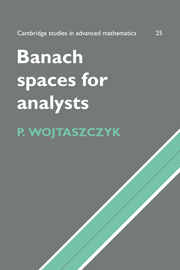Part I - Introduction
Published online by Cambridge University Press: 03 May 2010
Summary
This introductory part contains background material. It is not intended to be a course in any subject. It is simply a collection of definitions and facts given without proof (with one exception). We provide references to works which contain detailed exposition, full proofs, examples and motivation. In a sense this whole part is a quick reference guide to results which will be used in the later parts. The introduction is divided into two chapters, Chapter I.A describing what we will need from general functional analysis and Chapter I.B which contains results about concrete spaces and operators. Since I.A is really a review of a standard course in functional analysis, references are given only at the end of the chapter. In I.B we give references after each paragraph.
The references given in this part are usually to standard textbooks and monographs, not to original works. If a particular result or subject cannot be easily located using the table of contents or index we try to provide more detailed information (sections or pages). Sometimes we formulate a result in a form which is more convenient to us but different from the one given in the reference. Usually in such a case it is easy to derive our formulation from the one given in the reference.
- Type
- Chapter
- Information
- Banach Spaces for Analysts , pp. 1 - 2Publisher: Cambridge University PressPrint publication year: 1991



